Rewarewa is a tall, slender conical-spaped tree which reaches about 30 metres in the forest. Its angular branches slope upwards. In mature trees the entire lower-half of the trunk may be bare of branches. The young trees though are slender cones tightly wrapped in leaves and branches, very conspicuous in regenerating forest -- there is a very nice photograph of a grove of rewarewa in that environment in Dawson and Lucas's New Zealand's Native Trees (p. 295). It is found in forests throughout the North Island from sea level to about 85 m., and in the northern fringe of the South Island.
The tropical and Aotearoa "rewa" have in common their long leaves -- this similarity is quite apparent when you encounter the trees in person, although in many other respects they are quite different. For a start, the flowers of the New Zealand tree produce a beautifully flavoured nectar eminently suitable for human consumption -- it was stored in hue (gourds) and sipped through a reed straw as a remedy for sore throats. These days it is the basis for commercially produced rewarewa honey. The seeds and stems of its tropical namesake contain a deadly poison much utilized for murder and suicide! The shapes of the trees are also very different, with the Knightia having a slim, tapering conical shape retained into maturity, while the Cerbera is a much more spreading tree. Similarly the Knightia fruit is a slim pod, whereas the Cerbera is roundish or oval and considerably larger. The wood of both trees however is bouyant when dry. The Knightia pods open into a facsimile of a Māori voyaging canoe, complete with prow, whereas a split Cerbera fruit would be more like a coracle.
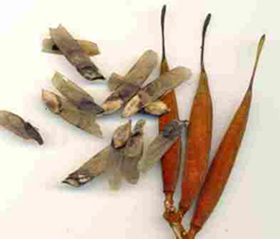 The leaves of the rewarewa are long (up to 40 cm), light green, and tapering, narrow along most of the length in young trees, with prominent serrations. They become leathery, shorter (around 15 cm), stubbier, a little wider towards the middle, and lose their translucent quality in more mature trees. All emergent leaves, young branchlets, inflorescences and seed pods are covered with a velvety red-brown tomentum. The nectar-rich flowers are produced in Spring and early Summer, and are pollinated by the tui, korimako and bees which feast on their bounty. After flowering, seed pods about 3-4 cm long develop, but will not be ready to disperse the seed until the following Spring, so a tree may have this years flowers and last year's fruit present at the same time. The seeds are winged, and dispersed by wind-- the seeds themselves are about 1 cm long, and the wings add an extra 15-20 mm (see illustration to the left). The seeds germinate readily and the plants thrive in sheltered environments. They will grow even in frost-prone areas if well-protected when young. The leaves of the rewarewa are long (up to 40 cm), light green, and tapering, narrow along most of the length in young trees, with prominent serrations. They become leathery, shorter (around 15 cm), stubbier, a little wider towards the middle, and lose their translucent quality in more mature trees. All emergent leaves, young branchlets, inflorescences and seed pods are covered with a velvety red-brown tomentum. The nectar-rich flowers are produced in Spring and early Summer, and are pollinated by the tui, korimako and bees which feast on their bounty. After flowering, seed pods about 3-4 cm long develop, but will not be ready to disperse the seed until the following Spring, so a tree may have this years flowers and last year's fruit present at the same time. The seeds are winged, and dispersed by wind-- the seeds themselves are about 1 cm long, and the wings add an extra 15-20 mm (see illustration to the left). The seeds germinate readily and the plants thrive in sheltered environments. They will grow even in frost-prone areas if well-protected when young.
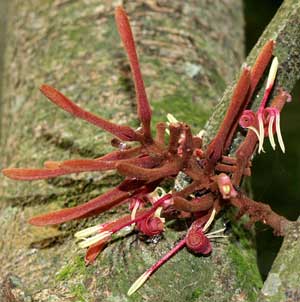 There is an excellent account of the development of the inflorescence in Laing and Blackwell's Plants of New Zealand (p.151). The inflorescence develops as a set of velvety tubes arranged around a central post. Each tube develops at its oen pace, in three stages. (1) The top of the tube opens first, very slightly, exposing the tip of the style (the stalk that connects the stigma -- the receptacle for the pollen -- with the ovary). (2) It then splits open for a short distance into four separate segments at the base of the perianth (the outer part of the flower, above the flower stalk) -- most of the tube is still closed. (3) The tube suddenly bursts, the segments roll down and coil into spiral segments at the base of the perianth. When they have all done this, the flower has a very different appearance from the bud. Each of these stages in individual tubes can be seen in the photograph on the left, and in another in the gallery below. The flowers are pollinated by birds getting pollen on their heads when drinking nectar from the flowers and depositing it when they brush against the stigmas. The stigmas develop later than the anthers (pollen-bearing organs) in individual flowers, so there is little chance of a flower being fertilized by its own pollen. There is an excellent account of the development of the inflorescence in Laing and Blackwell's Plants of New Zealand (p.151). The inflorescence develops as a set of velvety tubes arranged around a central post. Each tube develops at its oen pace, in three stages. (1) The top of the tube opens first, very slightly, exposing the tip of the style (the stalk that connects the stigma -- the receptacle for the pollen -- with the ovary). (2) It then splits open for a short distance into four separate segments at the base of the perianth (the outer part of the flower, above the flower stalk) -- most of the tube is still closed. (3) The tube suddenly bursts, the segments roll down and coil into spiral segments at the base of the perianth. When they have all done this, the flower has a very different appearance from the bud. Each of these stages in individual tubes can be seen in the photograph on the left, and in another in the gallery below. The flowers are pollinated by birds getting pollen on their heads when drinking nectar from the flowers and depositing it when they brush against the stigmas. The stigmas develop later than the anthers (pollen-bearing organs) in individual flowers, so there is little chance of a flower being fertilized by its own pollen.
The New Zealand species is endemic, with two related species of the same genus in New Caledonia. The rewarewa and one other tree (the toru, Toronia toru) are sole representatives of the Protea family in New Zealand, remnants of the Gondwanaland flora shared with New Caledonia while there was still a land bridge between the islands -- the last remnant of continental Aotearoa -- up to about 40 million years ago, and with Australia before that (George Gibbs, Ghosts of Gondwana, p.80). The rewa is also one of the relatively few richly coloured flowers in the New Zealand landscape -- the flowers of most indigenous species have evolved as white or green over the millennia.
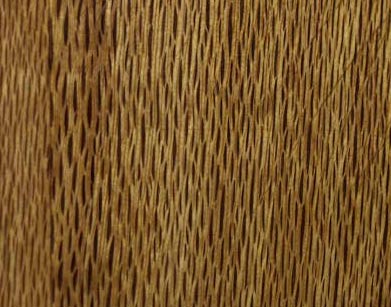 The wood of the rewarewa is beautifully flecked and greatly esteemed for parquet flooring, panneling and decorative purposes. For certain other purposes it is not considered to be appropriate.
It is
difficult to burn, but charcoal produced from the wood once ignited retains the heat for a long time and was used by canoe builders to help them hollow out the interior of logs. Despite this quality it was apparently not used for cooking, in some circumstances at least. Elsdon Best in Maori Agriculture (p. 266) recounts an interesting observation about how the roots of Cordyline pumilio (tī papa, a dwarf relative of the pan-Polynesian staple tī, Cordyline fruticosa) were cooked in certain districts: The wood of the rewarewa is beautifully flecked and greatly esteemed for parquet flooring, panneling and decorative purposes. For certain other purposes it is not considered to be appropriate.
It is
difficult to burn, but charcoal produced from the wood once ignited retains the heat for a long time and was used by canoe builders to help them hollow out the interior of logs. Despite this quality it was apparently not used for cooking, in some circumstances at least. Elsdon Best in Maori Agriculture (p. 266) recounts an interesting observation about how the roots of Cordyline pumilio (tī papa, a dwarf relative of the pan-Polynesian staple tī, Cordyline fruticosa) were cooked in certain districts:
Manuka (Leptospermum) was used as fuel to heat the oven. The wood of the rewarewa (honeysuckle) was not allowed to be used for this purpose because its wood, when decayed, is phosphorescent, like a glow worm, which latter is the offspring of Tangaroa-piri-whare, the mischief maker, and if the wood was used for such a purpose some mishap would occur to future crops.
The inner part of the bark has medicinal uses -- it was used to arrest bleeding and promote the healing of wounds. The trunk has a stippled appearance in young trees, and shows scars where the leaves have become detached. Adult trees have a quite smooth brownish bark.
|
Photographs: The photos in the galleries are acknowledged in the captions. The inset photos are: [1] Seeds and seed pods (Wayne Bennett); [2] Rewarewa flower, Te Māra Reo; and [3] Rewarewa wood (RB).
Citation: This page may be cited as: R. A. Benton (2022) "Rewarewa" (web page periodically updated), Te Mara Reo. "http://www.temarareo.org/TMR-Rewa.html" (Date accessed)
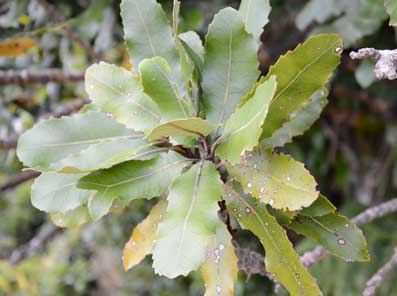 Knightia excelsa, Rewarewa (Foliage, mature tree) Knightia excelsa, Rewarewa (Foliage, mature tree)
(Mt Karioi, Waikato. Photo: John Sawyer, (c) NZPCN)
| 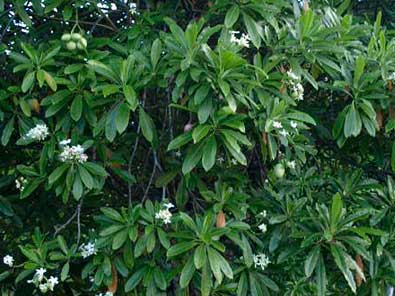 Cerebra manghas, Leva (Samoa) (Foliage, flowers & fruit) Cerebra manghas, Leva (Samoa) (Foliage, flowers & fruit)
Tiapapata, Upolu, Samoa |
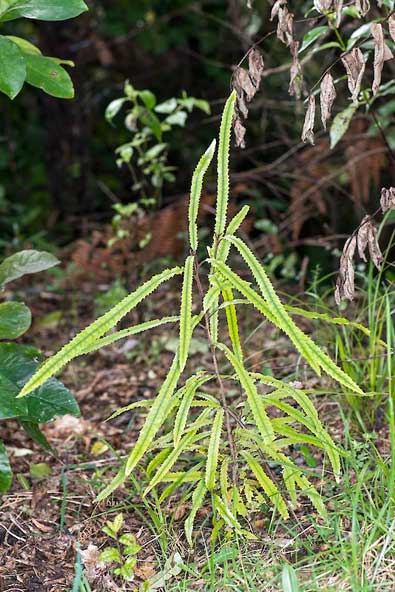 Knightia excelsa, Rewarewa (Seedling) Knightia excelsa, Rewarewa (Seedling)
(Western Hutt Hills. Photo: (c) Jeremy Rolfe, NZPCN.)
| 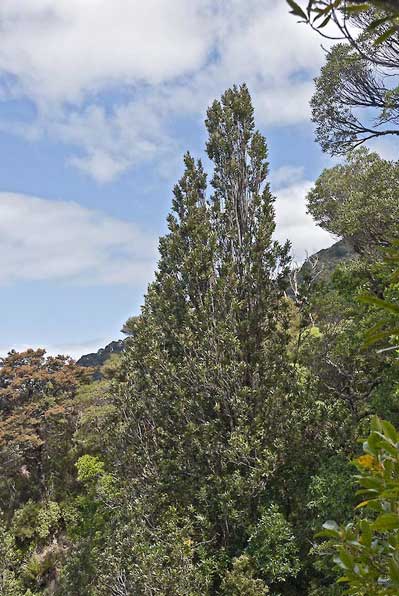 Knightia excelsa, Rewarewa (Mature tree) Knightia excelsa, Rewarewa (Mature tree)
Coromandel, NZ. Photo: John Smith-Dodsworth (c) NZPCN.) |
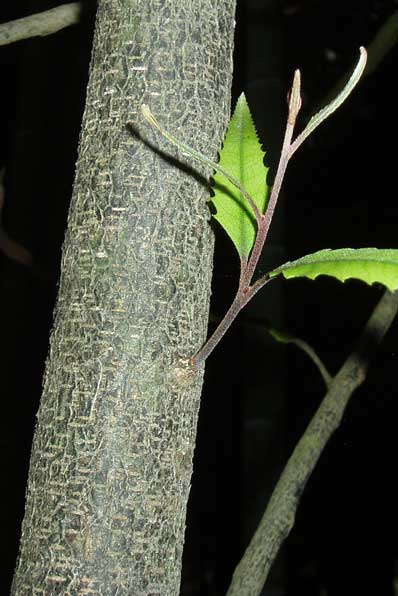 Knightia excelsa, Rewarewa (Trunk, young tree) Knightia excelsa, Rewarewa (Trunk, young tree)
(Te Māra Reo, Waikato)
|
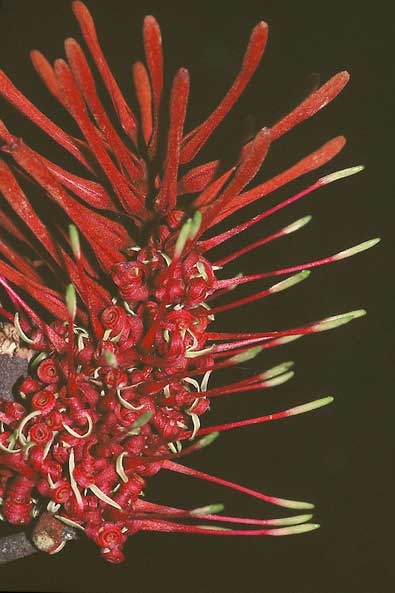 Flower (Rewa) of Knightia excelsa, Rewarewa Flower (Rewa) of Knightia excelsa, Rewarewa
(Manurewa, Auckland. Photograph: (c) Gillian Crowcroft, NZPCN) |
|

